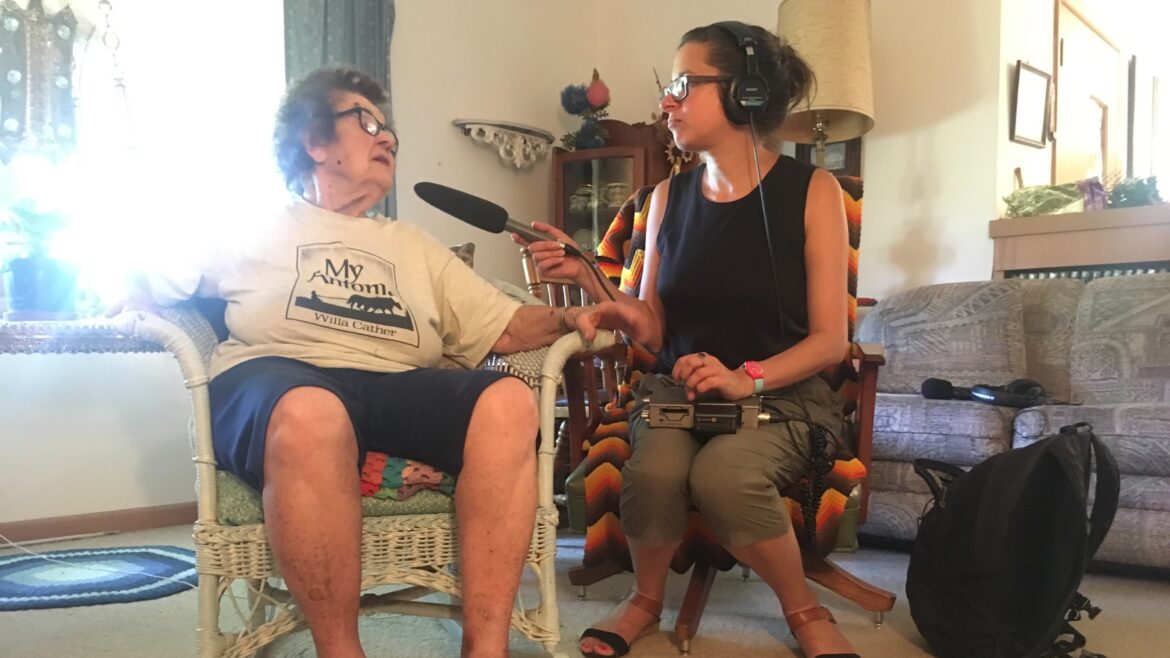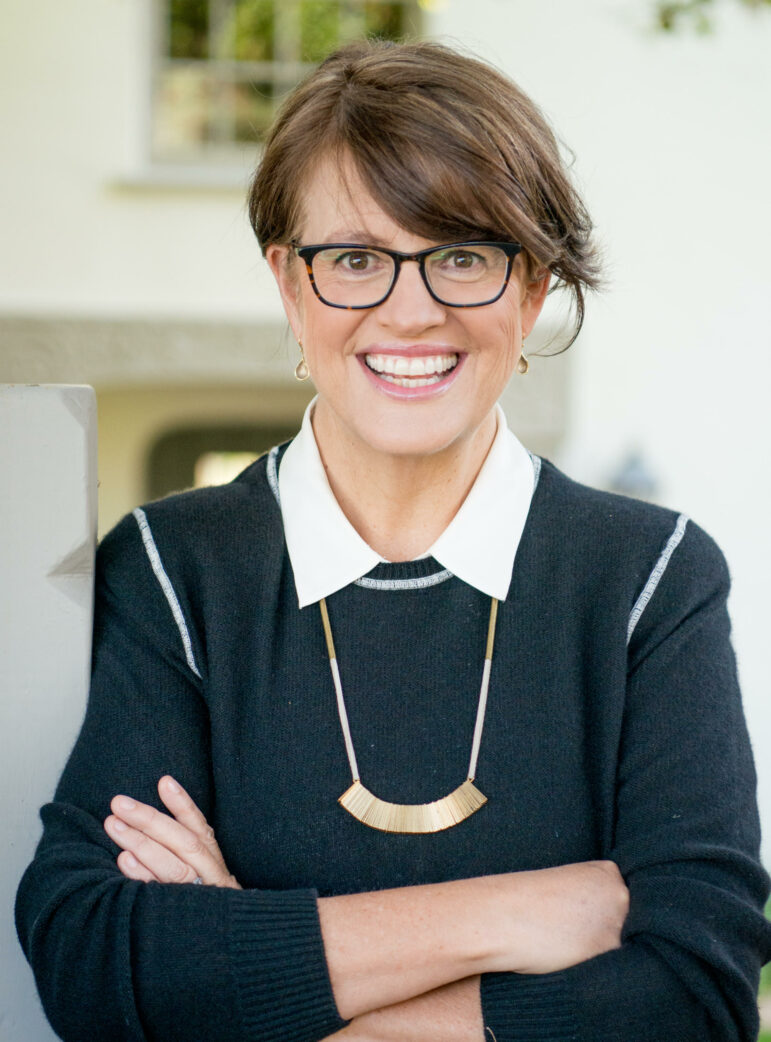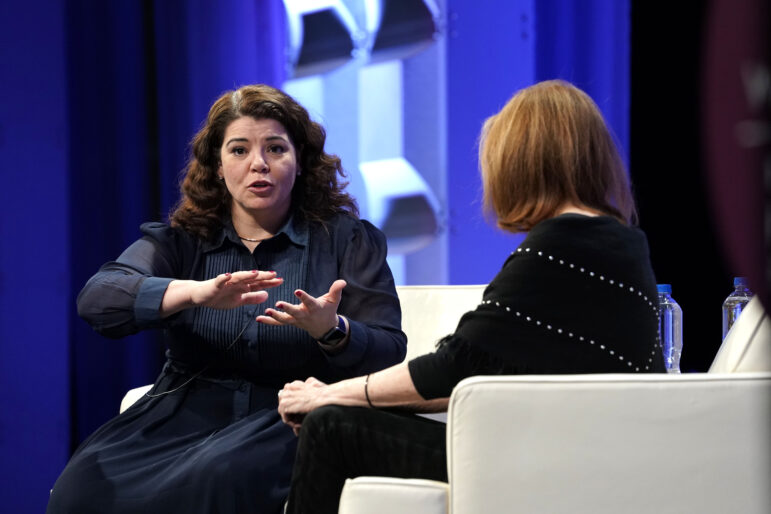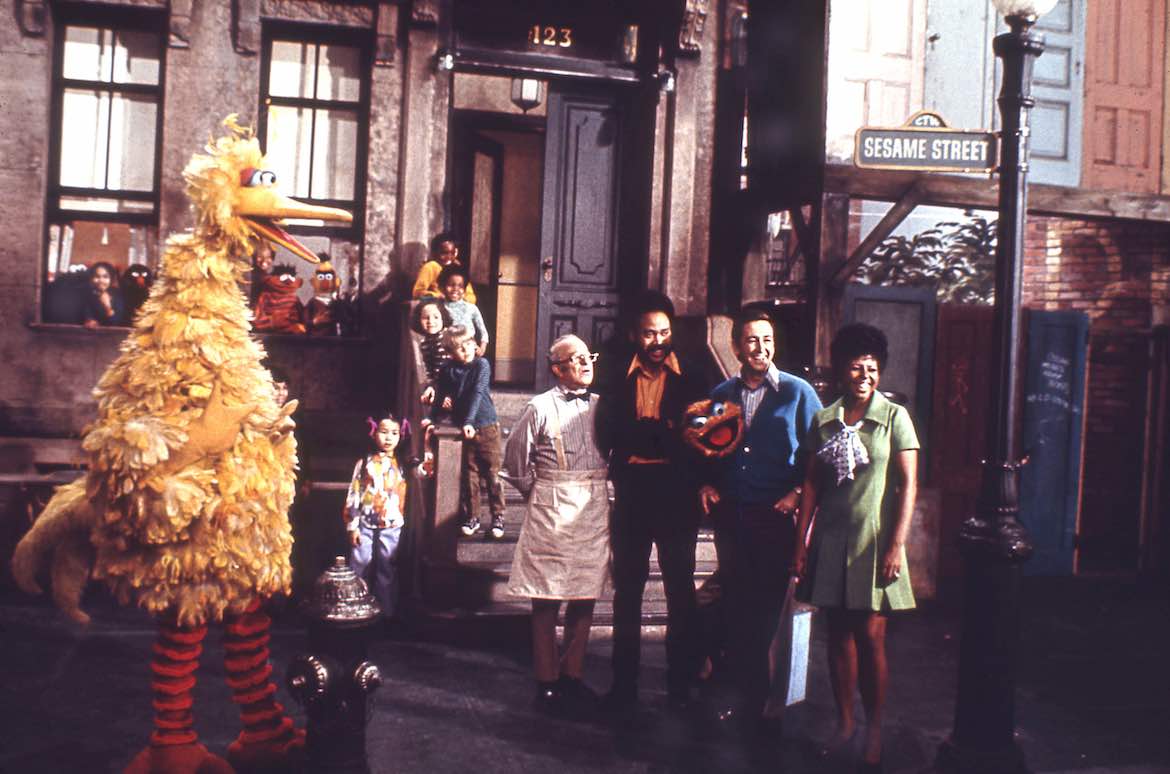How to elevate your audio interviews from good to great

Sally Herships interviews the granddaughter of the real Antonia from Willa Cather's "My Antonia" in Nebraska for "Studio 360."
Last week, Ronald Young Jr. swept the fourth annual Ambies awards for excellence in audio. He walked away with three trophies, the most of the night, for his revealing series, Weight for It, distributed by Radiotopia. Emblazoned on those glass icons: Best Indie Podcast, Best Indie Host and Best Society and Culture Podcast for his series exploring our uncomfortable relationship with weight — including his own.
Young, who is bald with a full beard and an infectious smile, is an astonishingly dynamic, self-aware storyteller — he actually broke into song as he described his approach to storytelling on my podcast, Sound Judgment.
Such dynamism and musicality goes a long way toward captivating audiences. Of course, some of what makes Weight for It so captivating is that it is a personal, confessional podcast, motivated by Young’s own relationship with his weight. At the same time, however, the series goes far beyond his experience. He delves into the myriad troubling byproducts of our fraught relationship with our bellies and hips, traveling from shame to stigma to inclusivity and lack thereof. All of that meant Young, like most creators, needed to conduct interviews to build such a provocative and resonant series.
Interviews are the foundation of all nonfiction storytelling — from the obvious long-form conversations at the heart of most public media midday shows to spot news, features and documentaries. One reason I believe Young had such a great night at the Ambies this year is because of his interviewing prowess. He selects his sources carefully — sources who offer unusual, vulnerable responses to his well-considered questions.
For instance, early in the series, he wanted listeners to think about shame. Instead of the obvious choice — a source who is ashamed of their weight — he talked to an average-weight friend, Damon Young (no relation) about shame. Damon Young offered a moving story about his crooked teeth. By approaching the theme creatively, Ronald Young Jr. provided a window into a series about weight that made it resonate with anyone who has ever judged or felt judged about any aspect of their appearance. In other words, everyone.
Damon Young: For years, years, I felt shame about my teeth. You know, I got teased about them a bit when I was a kid, I had a gap between my front teeth and also my parents couldn’t afford braces. So that was like another layer of shame. The shame of, you know, just not having much. And in America, teeth are a billboard that acknowledges class. You know, if you watch a cartoon of villains, they usually have bad teeth. If someone has mostly bad teeth, they’re usually like a villain, or meant to be stupid.
Ronald Young Jr.: Damon is stating something here that I know intimately. The idea that something was decided about the way we’re supposed to look. It’s always hard to determine the origin of that decision. But that decision about how we look, that judgment? It’s echoed in our conversations, in our culture, and in our art. And as a result, those of us who exist outside of the decided standard, just trying to live our lives, now have to bear the shame. In this case, Damon is talking about his teeth and the messaging that comes with bad teeth in society — that it’s inherently tied to flaws in character and low intelligence. Logically, most of us know that isn’t true.
Perhaps through experience, Young is capable of putting sources at ease and asking what, for many of us, would be uncomfortable questions — both of which are common interviewing challenges.
Interviewing is tricky. But, like many editorial necessities, newsrooms typically offer little or no training on interviewing skills, leaving newer reporters and producers to figure it out on the job — the very busy, high-stakes job.
In that spirit, here are six practical interviewing strategies for reporters, producers and hosts, drawn from the day-to-day practices of some of today’s best audio storytellers.
1. Guest curation #1: Know your purpose and let it guide you
Sometimes we think the problem with a flat or wandering interview is that we asked lousy questions or the source wasn’t a “good talker,” when that’s not the problem. The real problem is a lack of clear guidelines for guest and source curation. Why does this person belong on this specific show? Why will listeners care? Why is that person the right one to answer my question for a particular story?
By definition, curation guidelines are specific to the show and the audience; there is no one-size-fits-all. Understanding your purpose is critical, though: It gives you logic for choosing one guest or source over another; it’s a decision-making rubric for choosing one story or line of inquiry over another. Curation guidelines (“We interview policymakers in Maryland but not all over the East Coast”) help define your show.
Consider how Terry Gross explained the Fresh Air guest selection process to a Public Radio Program Directors conference audience last September. (PRPD is now known as the Public Media Content Collective.) Fresh Air’s guideline for cultural interviews is, “Do we legitimately love their work?”
I think of our [cultural] interviews as connecting somebody’s life to their sensibility. We book people because we love their work. We think their movies are great, or the book is great, or we love their music. So part of the goal … is to try to connect their life and their sensibility. What happened in your life that created a sensibility that we love? What happened in your life that enabled you to do this work and express yourself in the way that you do, that created your taste and your manner?
2. Guest curation #2: Seek a variety of perspectives
Another challenge is a function of time, inexperience or both: consistently choosing the obvious official source to respond to a news event or a trend, rather than seeking the perspective of someone closer to the action. We see this over and over again throughout public media (and media generally): Reporters talk with organizers, nonprofit directors, politicians and other officials, when it could be far more impactful to speak with people directly affected by the news. (This knee-jerk “choose the titled person” technique also often fails to help us meet stated goals of serving the entire community by bringing more under-represented voices to the public conversation.)
Anna Sale, host of Death, Sex and Money, offers an example of how to curate guests more thoughtfully. She and producer Zoe Azulay were researching “Bells to Bills: The Price You Pay for Your Wedding,” an episode prompted by post-pandemic increases in wedding costs. They chose to look for people for whom the stakes were high. Some time- or creativity-strapped producers would have interviewed wedding planners or photographers. Azulay was curious about engaged or recently married couples. “Pulling off a $20,000 wedding, if you’re inviting people and doing the things that wedding events take — flowers, caterers, etc. — that’s really hard to do,” Sale said. “We wanted to catch people as they were reckoning with the real cost of things in this moment and hear about why they were making the choices they were making.”
The result was an intimate, memorable portrait of the conflicts, joys and anxieties created when wedding desires and budget constraints collide.
Is it harder to find “real people” when curating guests? It can be. But it’s worth double-checking our first impulses about whom to interview. When I first conceptualize a story, series or show segment, I get curious about the different people and perspectives associated with any resonant issue. Who is making the news? Who is affected by it? How?
Here’s a mind map of this thought process, using as an example the recent settlement by the National Association of Realtors that effectively ends the practice of “mandatory” 6% real estate commissions. Much of the initial news focused on one impact: Housing prices are likely to drop. But it’s easy to imagine how widespread and varied the effects could be, depending on the role you play within the housing system.
For example, perhaps there’s a story to be told about a newcomer to the real estate business who now will decide she must find a different profession. Perhaps this will have economic implications for people more indirectly involved, like an instructor at a real estate school, a house flipper or a corporate investor. What was the drama like for the lawyers who both prosecuted and defended this case? Curiosity will lead you to new and interesting stories — and new and surprising sources.
3. How to find sources and convince them to talk with you
Of course, not everyone wants the press to find them. Investigative reporter Sally Herships confronted this problem over and over again as she reported an episode of The Heist from the Center for Public Integrity about Steven Mnuchin, the U.S. Treasury secretary in the Trump administration. She wanted to understand his background: How had his growing-up years led him to the heights of power?
She began tracking down anyone who could have known him, starting with a tried-and-true tool: his old school yearbooks. Beginning with middle-school teachers and high-school classmates, she wound up with spreadsheets of hundreds of potential sources.
At first, most wouldn’t talk. Herships cracked the code of cold outreach by tweaking emails and their subject lines to make them friendlier to those nervous about speaking with journalists. After receiving a bunch of rejections, she replaced the word “interview” in the subject line with “Coffee?” (While friendlier, she was still up-front about identifying herself as a reporter.) It worked.
4. Structuring an interview
An interview, especially for a show, needs a beginning, middle and end. Here’s more guidance from Terry Gross, once again from the September 2023 PRPD conference:
An interview should sound conversational, but it’s not a conversation. It needs some architecture. It needs some structure. It needs some research. …
We try to divide the interview into a narrative, into chapters, to make it easier to edit and to make it easier for the guest to follow the train of thought of the interview, and easier for the listeners to follow the narrative of the interview. It should have a narrative.
Of course, some guests are all over the place, and it doesn’t have a coherent narrative in the way that you wanted and that you structured on paper. So you listen, of course, to what the guest is saying and follow as best as you can where they’re trying to take you — while also trying to rein them back in to where you wanted to take them.
5. Set expectations
How can you help calm a nervous guest or shake the stiffness out of a wooden one? What you do before the interview starts makes a difference.
First, set expectations: What is your purpose in being together today? What do you plan to do with this interview? Will everything said be on the record?
If it’s appropriate, tell guests that if they stumble on their words, they can start a sentence again. If they want to rephrase something, they can; you’ll be editing anyway. Most people new to being interviewed are relieved to learn that this is possible. There is one big caveat, of course: Do not do this with investigative subjects, politicians or others from whom you are trying to glean hidden information or hold to account.
Let guests know the tone you’re looking for. Do you want this to feel and sound like a relaxed conversation? Say so! Do you want guests to share anecdotes? Model a storytelling approach by changing up your sound check question. Instead of falling back on “What did you have for breakfast?” try a question that naturally elicits a story, such as “What was your first car?” People always have interesting, often funny stories about their first car. Laughing together will connect you quickly.
(Tip: Just starting out? Start taping right away, during your “housekeeping” questions. You never know when you might want to use a surprising or funny throwaway.)

In the interview itself, Kelly Corrigan of the PBS show Tell Me More with Kelly Corrigan often starts with, “How would your mother describe you?” On her show On Being, Krista Tippett has long started by asking guests to share the spiritual backgrounds of their childhood homes.
Questions like this spark rapport, and there’s a scientific reason why: As Charles Duhigg learned while researching the psychology of conversation for his new book Supercommunicators, they’re “deep” questions. “If we ask questions that push people to think and talk about their values, beliefs and experiences, and then reciprocate with emotions of our own, we can’t help but listen to each other,” Duhigg writes. “‘The best listeners aren’t just listening,’ said [Yale psychologist] Margaret Clark. ‘They’re triggering emotions by asking questions, expressing their own emotions, doing things that prompt the other person to say something real.’”
Here’s how host Anne Bogel employs such a question at the top of her podcast, What Should I Read Next? In this example, she was interviewing a middle-aged daughter, Adrienne Hudson, and her 90-year-old mother, Barbara Costner. Bogel asked Hudson about the role reading played in her life growing up.
Hudson: We did move a lot. I remember that whenever we moved, the books got packed up, and they moved too. They weren’t discarded as part of the move. So the first house we had in Arizona, I remember you had a whole wall of bookshelves installed in the dining room.
Costner: Yeah.
Hudson: And it was just full of books. So books have always been, you know, part of the house I grew up in.
Through this unintrusive question about reading, we learn about their values, which are inherently interesting. The answers also provide listeners with context about who these guests are and why they should care about them. That’s an intentional strategy, Bogel says, because most of her guests aren’t well known.
Talking to someone who is a beloved teacher, mail carrier, hairstylist, dog sitter, you know, somebody who could be your niece, your nephew or your grandma … Our listeners don’t have the context for these guests that they do in the same way where if I said “We’re going to talk to fill-in-the-blank podcast host, author or TV star.”
So we try to ground the conversation about the books in the person’s reading life, to give our listeners a sense of what do they do and where are they in the world? What are all the different ways someone’s reading life can take form?
And everyone has a fascinating story to tell.
6. Be ready to fact-check on the fly
Of course, Bogel’s interviews are friendly. In a newsroom, being able to fact-check on the fly is critical, especially as we struggle for honesty in a world rife with disinformation.
It is virtually impossible to fact-check on the fly without good preparation beforehand.
When it comes to preparation, a good producer is an invaluable partner for any host. If you have the luxury of receiving research from a producer, thank them for their service — and make sure you thoroughly ground yourself in it before conducting an interview. Also, do your own research, especially when approaching potentially contentious or slippery conversations.
Keep your wits about you. When a guest offers an opinion disguised as a fact? Ask:
- “How do you know?”
- “What’s your evidence for this?”
- “What proof do you have?”
- “Give me an example.”
As a host or reporter, you are the listener’s advocate. “I am there to guide the conversation,” says Celeste Headlee, host of the Slate podcast Hear Me Out. “I need to keep it on target. And I need to keep that guest intellectually honest.”
Sometimes, it’s necessary to interrupt a guest to correct the facts. That was the case in an interview Headlee did with George Mason University professor Frank Buckley. He was arguing in favor of the South seceding from the U.S., using as an example of secession the popularity of a movement by activists in Quebec to secede from Canada. There was just one problem with his argument, though.

“There was no secession,” Headlee said. “At that point, he had mentioned it so many times, it was time for me to jump in.”
A Hear Me Out episode is designed to be a “smart, fair debate on issues that matter,” from secession and vaccinations to whether cat owners should allow their pets to roam freely outdoors. Headlee’s self-awareness about what her job is should be standard operating procedure for every interviewer: “My listeners don’t have time to do all the research that I’ve done. So I need to jump in and say when something isn’t true, it’s off base, or somebody’s changing the subject,” she said.
Where do we go from here?
I’ve covered six interviewing techniques: Purpose, perspective, persuasion, interview structure, setting expectations and knowing the facts — and being willing to step in and use them. These skills, though, are the tip of the iceberg: Great interviewers never stop learning.
With both misinformation and competition for audience attention at an all-time high, newsroom leaders should make interview training the norm, not the exception, for staffers and regular freelancers alike.
The alternative? We join the ranks of the ill-prepared interviewers who inspired Katharine Hepburn to say, “Death will be a great relief. No more interviews.”
Elaine Appleton Grant is EP and host of Sound Judgment and CEO of Podcast Allies, which provides host and editorial strategy coaching services to public media, nonprofits and higher education leaders. She offers public-facing and custom workshops on storytelling skills, including Mastering the Art of the Interview, coming up Friday.






